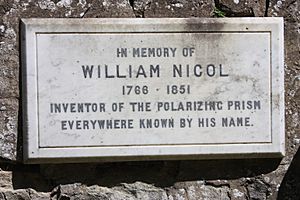William Nicol (geologist) facts for kids
William Nicol was a Scottish geologist and physicist. He is famous for inventing the Nicol prism in 1828. This prism was the first tool that could create a special kind of light called plane-polarized light.
Contents
Early Life
William Nicol was born in Humbie, a place in East Lothian, Scotland. His parents were Walter Nicol and Marion Fowler. While some records say he was born in 1768, others, like his baptism record, suggest 1770. His gravestone even says 1766, but this might be wrong as it was made much later.
A Popular Lecturer
Nicol started his career helping his uncle, Henry Moyes. His uncle was a traveling lecturer who taught about science, especially chemistry and optics. Because his uncle was blind, he needed help with his demonstrations.
Later, William Nicol became a very popular lecturer himself. He taught at the University of Edinburgh. He lived a quiet life in Edinburgh. Besides the prism named after him, he also studied tiny pockets of liquid inside crystals. He also looked closely at the microscopic structure of fossil wood. He kept his research findings private until 1826, when he finally started publishing them.
The Nicol Prism
Nicol created his special prism from a clear crystal called Iceland spar. This crystal is a natural form of calcium carbonate. He cut the crystal in a specific way, then glued the two halves back together using a sticky substance called Canada balsam.
When light enters the Nicol prism, it bends in two different directions. One of these light rays comes out as plane-polarized light. This invention made it much easier for scientists to study how light bends and how it can be polarized. Nicol prisms were later used to explore the tiny structures of molecules and how some organic compounds interact with light.
Studying Rocks Up Close
In 1815, Nicol developed a new way to prepare very thin slices of crystals and rocks. This allowed scientists to study them under a microscope. He thought of cutting thin slices of fossil wood to see its tiny plant structures.
Here's how he did it:
- He took a small piece from the rock or fossil.
- He ground one side perfectly flat and polished it.
- He then glued this flat side to a piece of glass using Canada balsam.
- Next, he ground down the other side of the rock until it was super thin. It became so thin that light could pass through it.
This method made it possible to see the inside structures of minerals using light that passed *through* them, instead of just light reflecting off the surface. Nicol made many thin slices of both fossil and modern woods. Many of these were described by Henry Witham in his book Observations of Fossil Vegetables (1831). Nicol provided the first public explanation of his special process in this book.
After Nicol passed away, his tools and prepared samples went to Alexander Bryson. Bryson added even more to these collections. He also made many new thin slices of minerals and rocks. He did this to show the tiny liquid-filled spaces that other scientists, like David Brewster, and Nicol himself had described earlier.
Death and Legacy
William Nicol died at his home in Edinburgh on September 2, 1851. His house was at 4 Inverleith Terrace, which is now numbered 12 Inverleith Terrace. He was buried in Warriston Cemetery. Today, a plaque on the east wall of the cemetery marks his burial spot.
A feature on the Moon called Dorsum Nicol is named after him, honoring his contributions to science.
See also
 In Spanish: William Nicol para niños
In Spanish: William Nicol para niños



